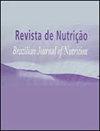Nutritional indicators of food and nutrition security of families: 2008/2009 Household Budget Survey
IF 0.5
4区 医学
Q4 NUTRITION & DIETETICS
Revista De Nutricao-brazilian Journal of Nutrition
Pub Date : 2023-05-19
DOI:10.1590/1678-9865202336e220110
引用次数: 0
Abstract
ABSTRACT Objective To evaluate the food and nutrition insecurity of Brazilian families, according to indicators of food consumption and nutritional status, by location and situation of the households investigated using the 2008/2009 Household Budget Survey. Methods Inadequate consumption of macronutrients and nutritional dystrophies (underweight, short stature or overweight) in at least one family member were used as indicators, according to location and geographical situation of households. The prevalence of food and nutritional insecurity and their confidence intervals were calculated. Results Food consumption was assessed in a total of 13,569 households; a total of 67.55%, 43.96% and 6.85% revealed inadequacy for lipids, carbohydrates and proteins, respectively. Among the 53,640 households assessed by nutritional status, 15.10%, 35.15% and 45.50% had, at least one resident with low weight, short stature or overweight respectively. The Northeastern Region showed statistically higher prevalence than other Brazilian macro-regions for inadequate lipids (24.88%) and carbohydrates (15.32%), as well as for the presence of underweight (6.15%), overweight (14.77%) and short stature (15.17%), in at least one of the residents of the household. Conclusion Assessing the nutritional aspect of food insecurity allows for a better understanding of the dimensions of this situation by considering the effects of access and availability of food, as well as biological use and stability, based on indicators of inadequate food consumption and the presence of nutritional dystrophy. The results found in this study enhance the need to include nutritional indicators in the assessment of food security.家庭粮食和营养安全营养指标:2008/2009年度家庭预算调查
【摘要】目的利用2008/2009年度家庭预算调查,根据巴西家庭的食物消费和营养状况指标,通过调查家庭的所在地和情况,评估巴西家庭的食物和营养不安全状况。方法根据家庭所在地和地理情况,以家庭成员中至少一人常量营养素摄入不足和营养不良(体重不足、身材矮小或超重)为指标。计算了粮食和营养不安全的发生率及其置信区间。结果调查了13569户家庭的食品消费情况;脂肪、碳水化合物和蛋白质不足的比例分别为67.55%、43.96%和6.85%。在接受营养状况评估的53640户家庭中,15.10%、35.15%和45.50%分别至少有一名居民体重过低、身材矮小或超重。从统计上看,东北地区的居民中至少有一人的血脂(24.88%)和碳水化合物(15.32%)不足,以及体重不足(6.15%)、超重(14.77%)和身材矮小(15.17%)的患病率高于巴西其他宏观地区。评估粮食不安全的营养方面,可以根据粮食消费不足和营养不良的指标,考虑粮食获取和供应的影响,以及生物利用和稳定性,从而更好地了解这种情况的各个方面。本研究发现的结果加强了将营养指标纳入粮食安全评估的必要性。
本文章由计算机程序翻译,如有差异,请以英文原文为准。
求助全文
约1分钟内获得全文
求助全文
来源期刊
CiteScore
1.20
自引率
12.50%
发文量
24
审稿时长
6-12 weeks
期刊介绍:
Revista de Nutrição is former Revista de Nutrição da Puccamp, founded in 1988. It is a bimonthly publication every four months and it is of responsibility of the Centro de Ciências da Vida, da Pontifícia Universidade Católica de Campinas . It publishes articles that contribute to the study of Nutrition in its many sub-areas and interfaces; and is open to contributions of the national and international scientific communities.

 求助内容:
求助内容: 应助结果提醒方式:
应助结果提醒方式:


